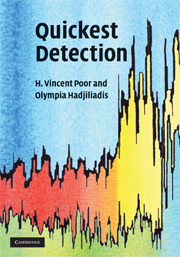6 - Non–Bayesian quickest detection
Published online by Cambridge University Press: 06 July 2010
Summary
Introduction
In Chapter 5, we considered the quickest detection problem within the framework proposed by Kolmogorov and Shiryaev, in which the unknown change point is assumed to be a random variable with a given, geometric, prior distribution. This formulation led to a very natural detection procedure; namely, announce a change at the first upcrossing of a suitable threshold by the posterior probability of a change. Although the assumption of a prior on the change point is rather natural in applications such as condition monitoring, there are other applications in which this assumption is unrealistic. For example, in surveillance or inspection systems, there is often no pre–existing statistical model for the occurence of intruders or flaws.
In such situations, an alternative to the formulations of Chapter 5 must be found, since the absence of a prior precludes the specification of expected delays and similar quantities that involve averaging over the change–point distribution. There are several very useful such formulations, and these will be discussed in this chapter.
We will primarily consider a notable formulation due to Lorden, in which the average delay is replaced with a worst–case value of delay. However, other formulations will be considered as well.
As in the Bayesian formulation of this problem, optimal stopping theory plays a major role in specifying the optimal procedure, although (as we shall see) more work is required here to place the problems of interest within the standard optimal stopping formulation of Chapter 3.
- Type
- Chapter
- Information
- Quickest Detection , pp. 130 - 173Publisher: Cambridge University PressPrint publication year: 2008

